The ocean covers more than 70 percent of the earth’s surface. And there are five oceans on this planet that are linked to one another to form what we call the global ocean. This vast marine ecosystem is home to numerous types of fish, living in both open and undiscovered parts of the deep oceans.
While some marine creatures tend to appear dull just to blend in with their environment, there are certain blue fish that aren’t afraid of drawing attention due to their vibrant skin colors.
So, if you’re a fan of blue fish, it will be worthwhile to know where you can find them. That being said, let’s take a look at each species to know more.
Table of Contents
1. Blue Threadfin Salmon (Eleutheronema tetradactylum)
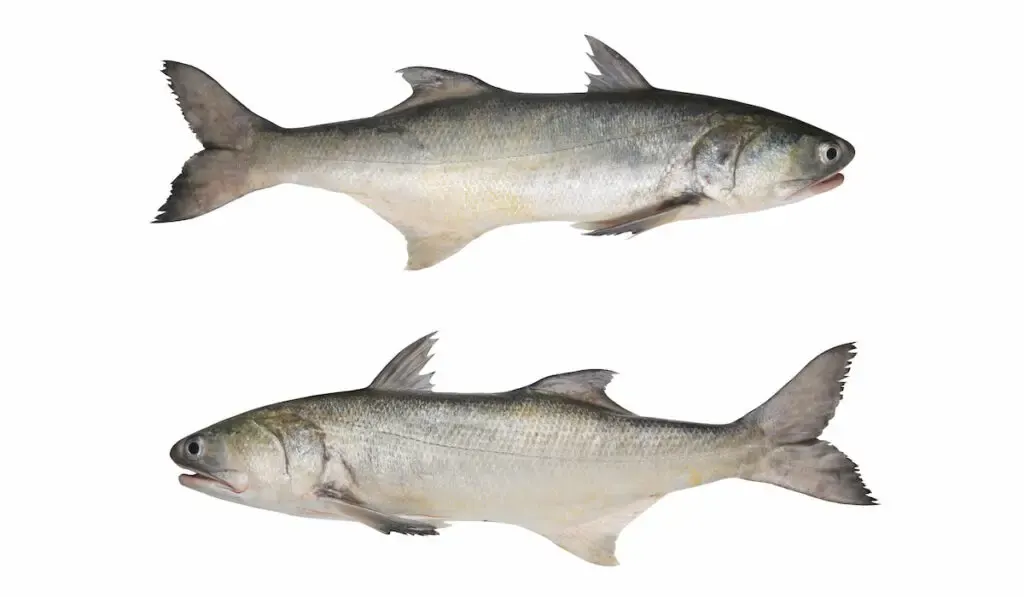
Blue threadfin salmon are native to the western Pacific and Indian oceans. They also go by many other names such as fourfinger threadfin, blue salmon, colonial salmon, bluenose salmon, and tassel-fish.
These fish swim near coastal waters but may also spend time near rivers.
You can spot blue threadfins by their silvery-blue skin, two upright dorsal and anal fins, and whisker-like sensory filaments located underneath their pectoral fins.
Blue threadfin salmons can grow up to 6.6 feet (2 meters) long. They are carnivorous fish that feed on various marine creatures such as worms, anchovies, prawns, gray mullets, crabs, and other small fish.
2. Horse Mackerel (Trachurus trachurus)
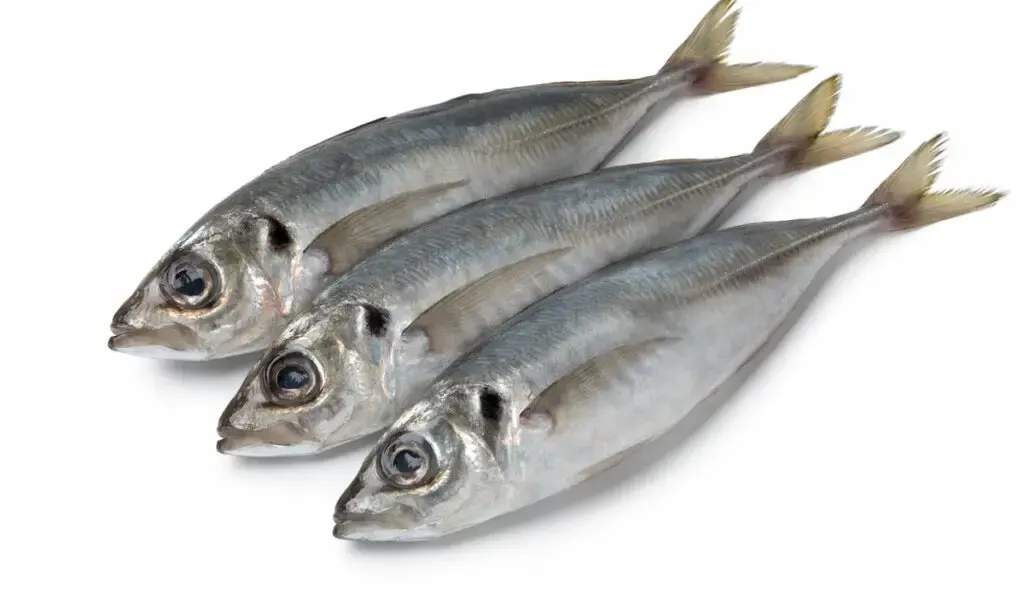
Horse mackerels are distributed throughout the warm water of the Pacific, Atlantic, and Indian oceans. These fish aren’t actually real mackerels. Instead, they are related to trevallies and jacks and belong to the family Carangidae. In Japanese, they also are called “aji”.
The two most common mackerels are Atlantic horse mackerels and Japanese horse mackerels. You can easily distinguish these two species from one another by their skin color. Atlantic horse mackerels possess silvery-blue skins, whereas Japanese horse mackerels have greenish-blue skins.
Horse mackerels often swim and live in schools. Depending on their age and size, they will feed on different creatures such as zooplanktons, crustaceans, mollusks, jellyfish, and small fish.
Their only main concern is predator attacks that come from large fish such as sharks, Orcas, and aerial predators such as seagulls.
3. Blue Ring Angelfish (Pomachantus annularis)
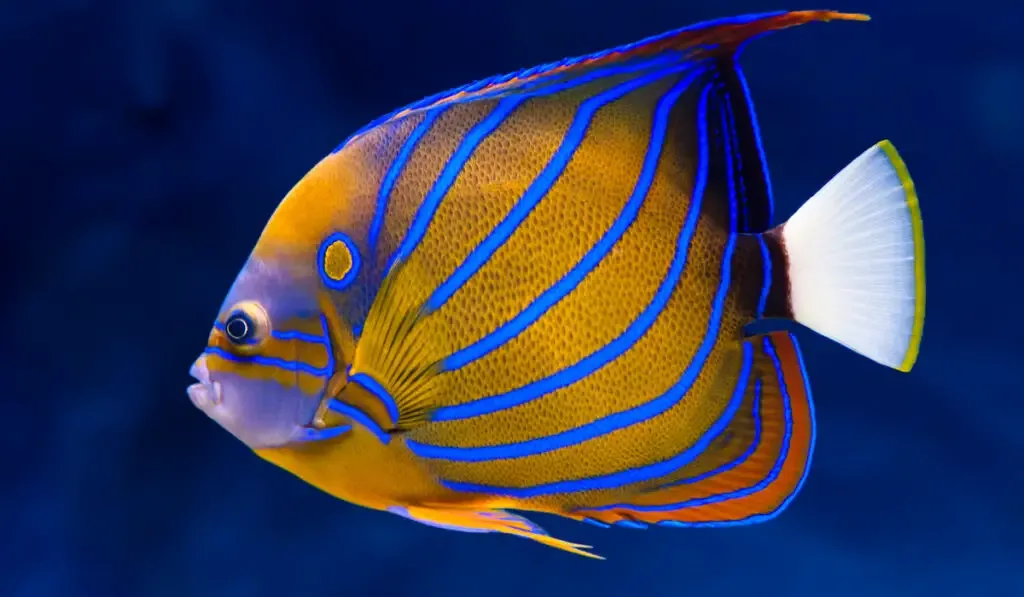
These vibrant-looking fish are indigenous to the Indo-West Pacific Oceans. They are also called the blue king angelfish and the annularis angelfish. Blue ring angelfish spend most of their coral reefs and hidden spots near coastal waters, jetties, wrecks, and caves.
You can recognize these fish by their yellowish bodies that are layered with bright blue curved stripes or rings and white tail fins.
However, juvenile fish are slightly different with dark blue or black bodies and white stripes. On average, Blue ring angelfish grow 12 to 18 inches long.
Unlike some species, these fish don’t swim in schools. Instead, they tend to stay with their mating partners or move alone. Their diet mainly consists of different things such as algae, zooplankton, sponges, tunicates, and sea squirts.
4. Atlantic Bluefin Tuna (Thunnus thynnus)
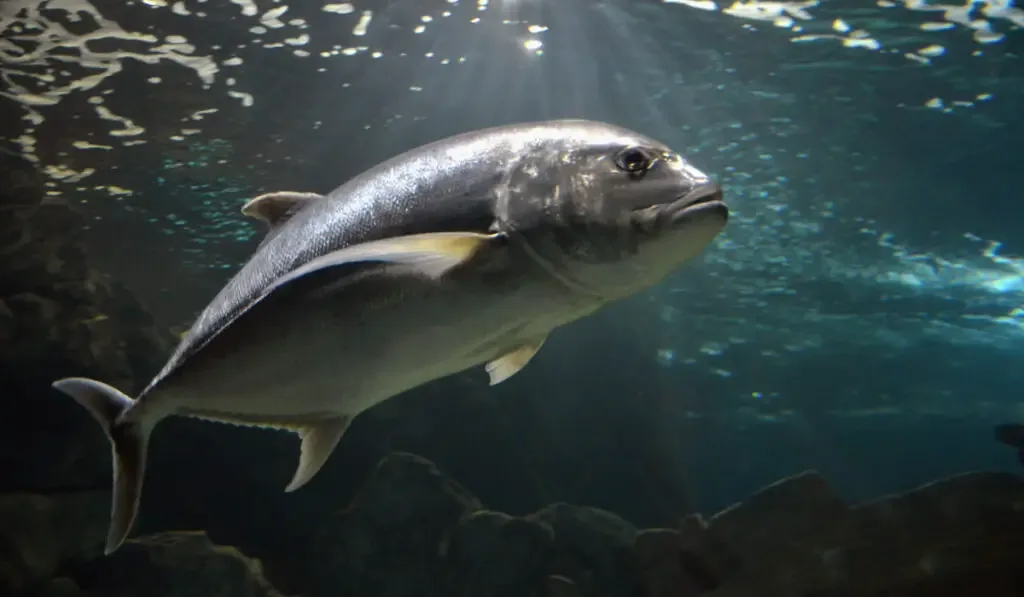
Atlantic bluefin tuna is widely distributed near the Atlantic Ocean and the Mediterranean Sea. Some people might know them as Tunny, giant bluefin tuna, and northern bluefin tuna.
These medium to large-sized fish measure 6 to 8.2 feet (1.8 to 2.4 meters) long and weigh 550 pounds (249 kilograms). In some cases, they can grow as heavy as 1 ton.
These tunas possess dual-toned bodies with dark blue upper parts, whitish-gray lower parts, and sharp, needle-like teeth. However, the easiest way to differentiate this species from other tuna species is by looking at their short pectoral fins.
On average, Atlantic bluefin tunas live up to 15 years and reach their mature size between 3 to 5 years.
Although these fish are preyed on by other humans and other large fish, they are considered predators of small fish and other marine creatures. They usually eat eels, sardines, mackerels, herrings, crustaceans, and squids.
5. Bluehead Wrasse (Thalassoma bifasciatum)
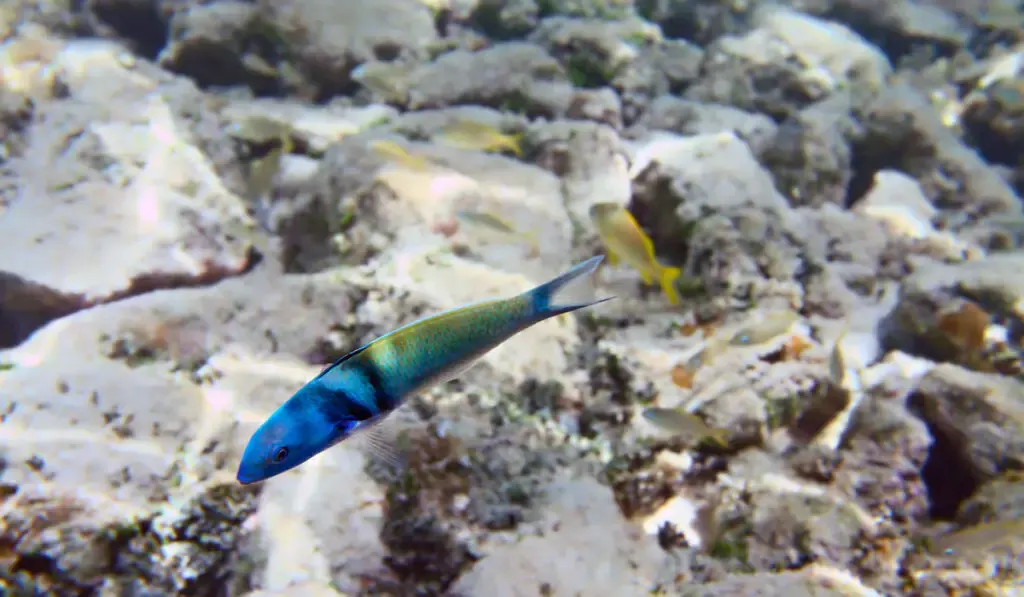
These vibrant fish are native to the Atlantic Ocean, particularly near the Gulf of Mexico and the Caribbean Sea. They are also known as blue-head wrasse or simply, the bluehead. If you’re an avid diver, you may find these fish near coral reefs in their native habitats/
Bluehead wrasses change color based on their life stages. Juvenile fish have yellowish-black bodies with lateral black stripes. As they mature, these fish appear greenish blue with bright blue heads.
Their lateral black stripes also turn darker and become clearly visible. These small fish measure 2 to 3 inches long. In some cases, they may grow up to 9.8 inches long.
Bluehead wrasses usually live up to 3 years. They are foragers that feed on various small to micro marine organisms such as zooplankton, shrimps, krill, crustaceans, and other small invertebrates. Not to mention, they also consume fish eggs and ectoparasites that live on other fish.
6. Powder Blue Tang (Acanthurus leucosternon)
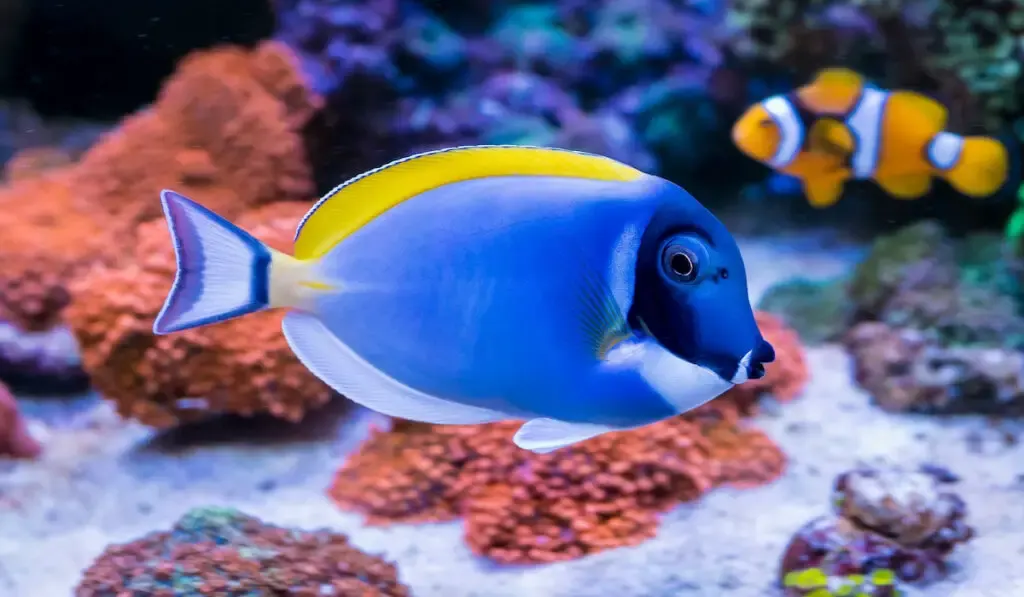
Powder blue tangs or powder blue surgeonfish are indigenous to the Western Pacific and Indian Oceans. They live near coral reefs in shallow coastal waters.
You can recognize these fish by their flat, oval-shaped, bright blue bodies, black heads, white chests and anal fins, and yellow caudal and dorsal fins.
On average, powder blue tangs grow 8 to 21 inches long. They also live up to 5 years in the ocean. But in captivity, they can live up to 10 years.
These fish are grazers that swim alone or in large groups. They mainly feed on benthic algae and can be quite territorial when their resources are scarce.
7. Humphead Wrasse (Cheilinus undulatus)
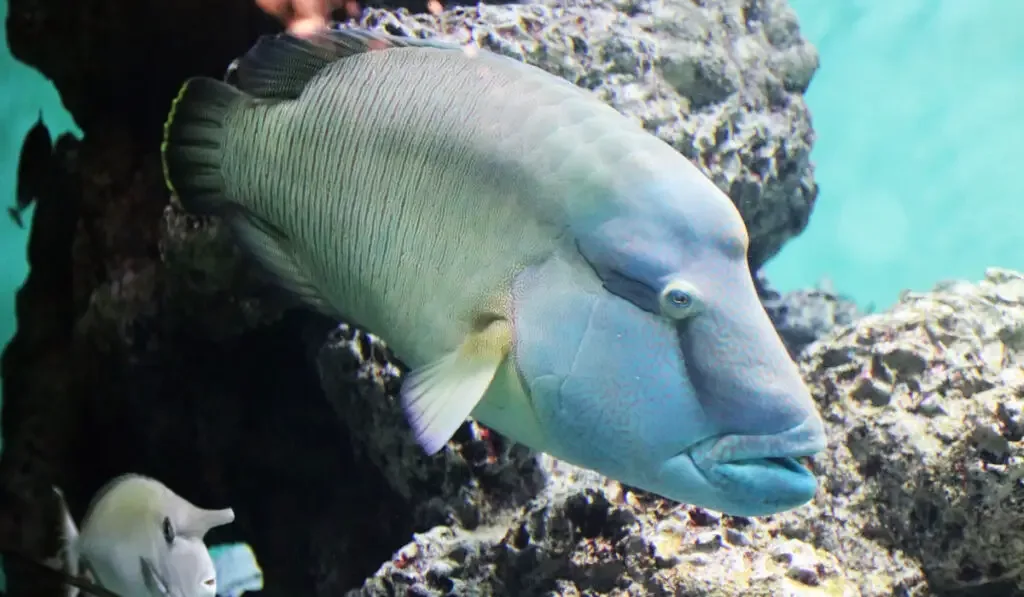
These large-sized, reef-dwelling fish are distributed throughout the Indian Oceans. They are also known as the Napolean wrasse. Humphead wrasses are found living near coral reefs of tropical waters. They rarely migrate or swim far away from their native habitats.
You can spot these wrasses by the large hump of their foreheads, thick lips, and bluish green to purplish green bodies. They can grow up to 6 feet (1.8 meters) long and weigh as heavy as 400 pounds (181 kilograms).
Humphead wrasses are active predators that feed on various marine creatures such as crustaceans, small fish, mollusks, and sea urchins. They are also capable of consuming toxic and poisonous starfish, sea hares, and boxfish.
The only thing that threatens humphead wrasses’ population is human predation. Due to being perceived as luxury collection items in Southeast Asia, these fish are captured and valued at $220 per pound (0.4 kilograms).
Other than that, habitat destruction and changes in sea temperature also contribute to the decrease in their total numbers.
8. Atlantic Blue Marlin (Makaira nigricans)
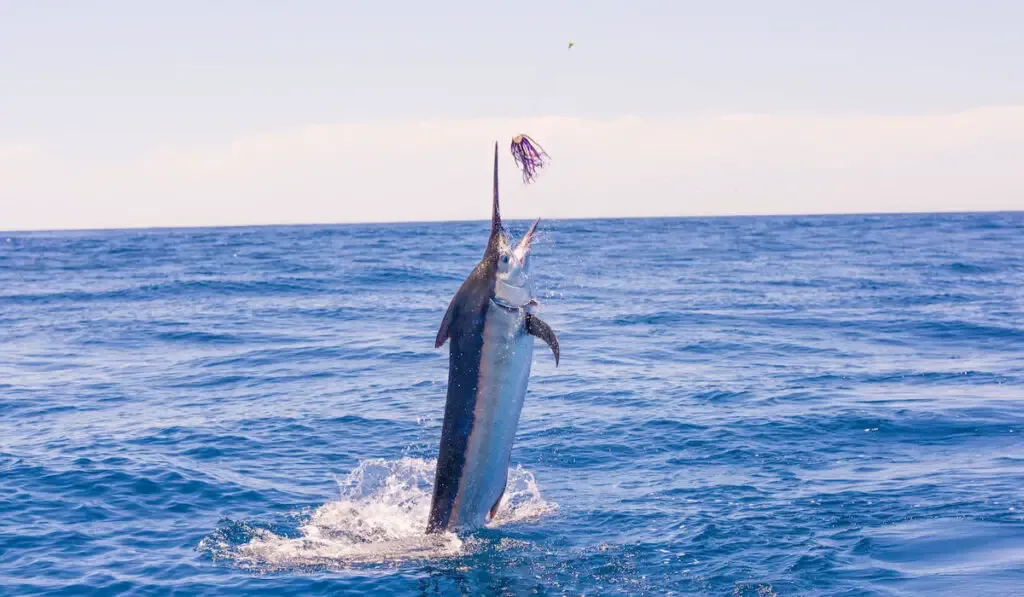
Like their name, these fish are native to the Atlantic Ocean. They were once known as the ocean guard and Cuban black marlin. Oftentimes, some people tend to assume that Atlantic blue marlins are related to swordfish.
However, they aren’t exactly the same. These fish are much bigger than swordfish. They also have ship-like dorsal fins, whereas swordfish possess shark-like dorsal fins.
Atlantic blue marlins typically swim in deep water regions in subtropical and tropical waters.
They have dark blue upper bodies, silvery-white lower parts, 15 cobalt-colored stripes located on each side of their bodies, and long and sharp snouts.
They can grow up to 16 feet (4.8 meters) long and weigh 1,803 pounds (817 kilograms). Previous records also showed that most female marlins are much bigger than males.
As predators, Atlantic blue marlins thrive on a carnivorous diet. They eat various fish such as sardines, tunas, mackerels, anchovies, flying fish, as well as squids. These fish are also host to many parasites such as barnacles, tapeworms, roundworms, spiny-headed worms, and copepods.
9. Yellowtail Damselfish (Chrysiptera parasema)
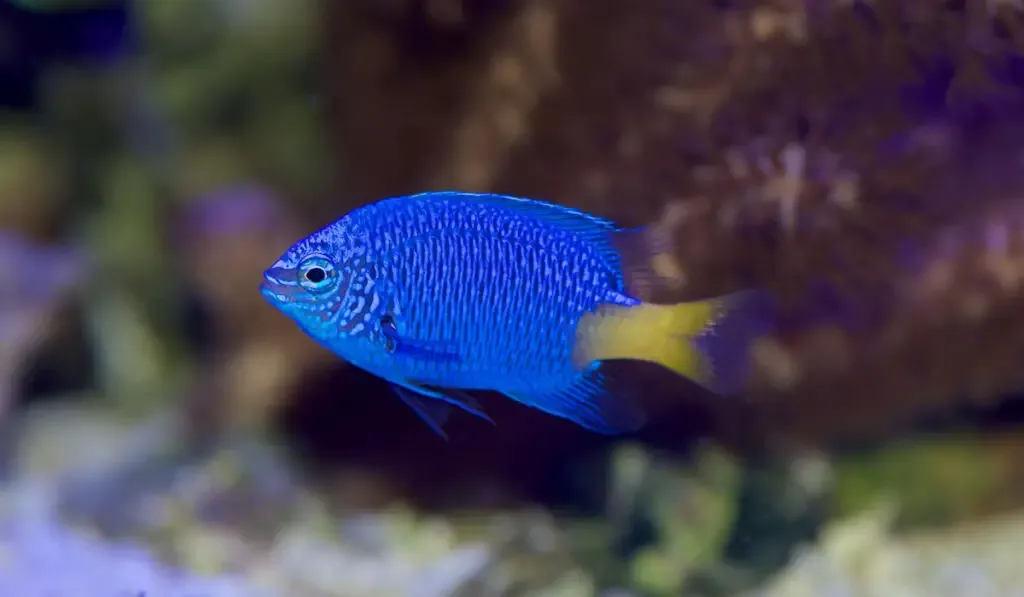
Yellowtail damselfish or yellow-tail blue damselfish are widely distributed near Indo-Pacific regions, particularly in Australia, Japan, and the Philippines. They usually spend most of their lives near lagoons, deep oceans, and protected inshore reefs with high coral populations in warm coastal waters.
You can spot these small fish by their vibrant blue bodies and yellow tail fin. They measure 2 to 3 inches long and weigh 9.9 ounces.
Yellowtail damselfish are territorial creatures. Hence, they can be quite aggressive in the presence of other fish. In the ocean, these fish can live between 2 to 6 years. But in captivity, their lifespan can extend up to 15 years.
These omnivorous fish feed on various small things ranging from zooplankton to algae and small crustaceans. If you’re thinking of starting your own saltwater aquarium, yellowtail damselfish would be a great addition to your fish collection. They are hardy, easy to maintain, and inexpensive to purchase.
10. Sapphire Devil (Chrysiptera cyanea)
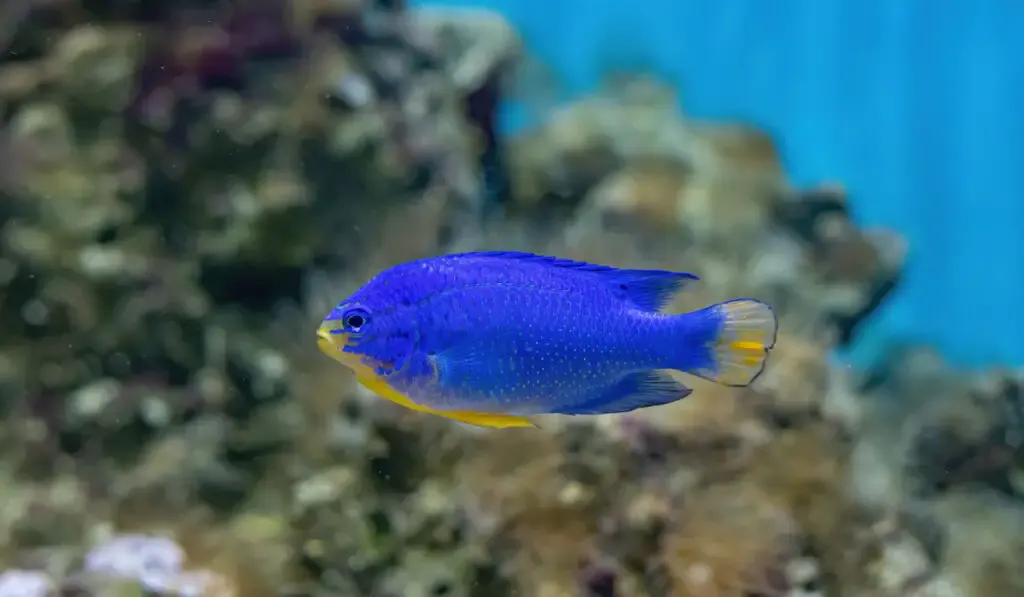
Sapphire devil fish, or simply blue devils, are native to Indo-West Pacific regions. They are found living near lagoons, reefs, and shallow coastal waters. These fish aren’t a solitary species. Hence, they always swim in small groups, usually led by males.
You can recognize sapphire devil fish by their bright, iridescent blue bodies and yellow tail fin. But what makes this species unique is their ability to change their blue skin to brown, especially when there’s a nearby threat.
On average, these small fish measure 3 inches long.
Sapphire devil fish usually eat zooplankton, algae, tunicates, and small crustaceans. The males are territorial and aggressive toward other fish, even those from the same species.
11. Yellowbar Angelfish (Pomacanthus maculosus)
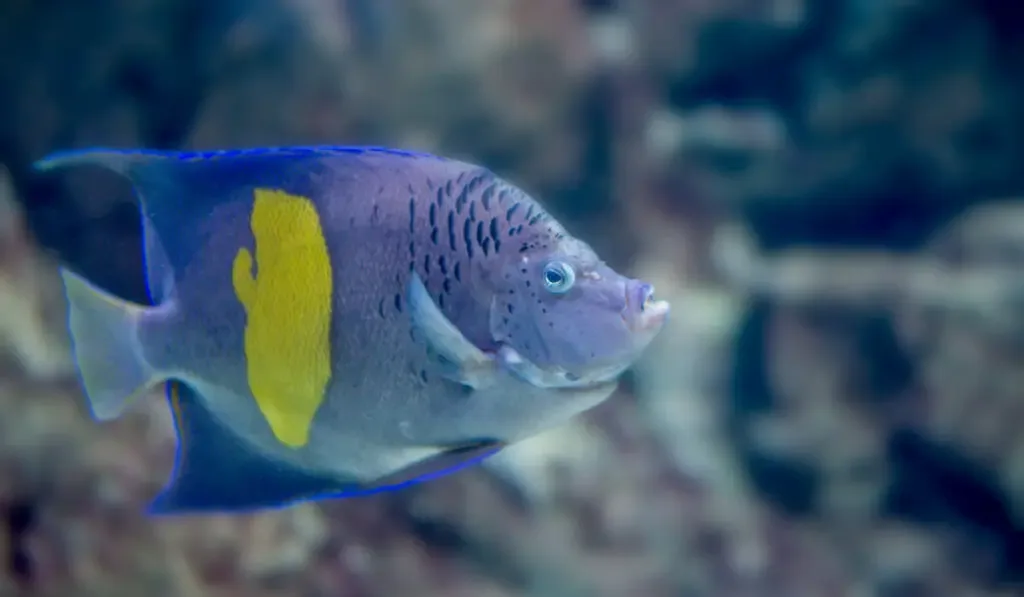
Yellowbar angelfish go by many names such as map angelfish, half-moon angelfish, and red sea angelfish. They are widely distributed in the western Indian Ocean and the eastern Mediterranean Sea. These fish inhabit sheltered areas filled with soft corals, silted bays, and shallow coastal waters.
Yellowbar angelfish possess flat, dark blue bodies with irregular-shaped yellow patches on each side of their bodies. But when they’re young, these fish have black bodies filled with vertical bright blue lines.
As they mature, these fish can reach up to 20 inches long.
Being omnivores, yellowbar angelfish eat various marine creatures such as algae, tunicates, sponges, and small invertebrates. Generally, they also live up to 20 years in their native habitats.
12. Cherub Pygmy Angelfish (Centropyge argi)
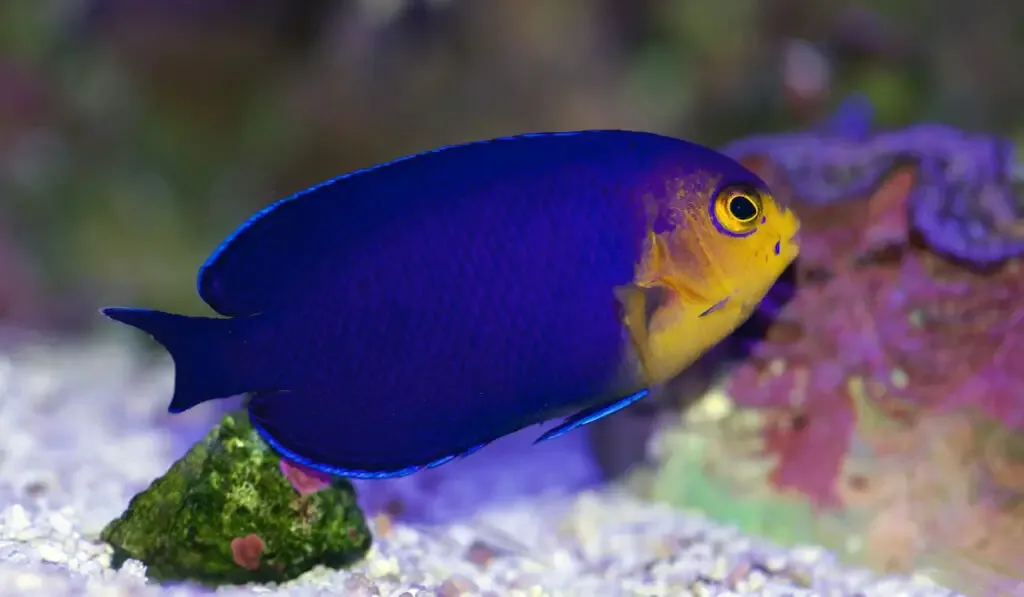
Cherub pygmy angelfish are native to the tropical waters in the western Atlantic Ocean. They usually spend most of their time in hidden spots like small rocks, coral rubble, and cavities.
They are also known as the pygmy angelfish, Atlantic pygmy angelfish, and cherub fish. They measure 3 inches long.
They have oval-shaped blue bodies, yellowish-orange faces, and white rings around their yellow eyes.
Cherub pygmy angelfish are also active omnivores. Being grazers, they feed on various things ranging from small benthic creatures to algae.
Like many angelfish species, they can turn hostile toward other fish. In the wild, they usually live up to 5 years.
13. Blue-Green Chromis (Chromis viridis)
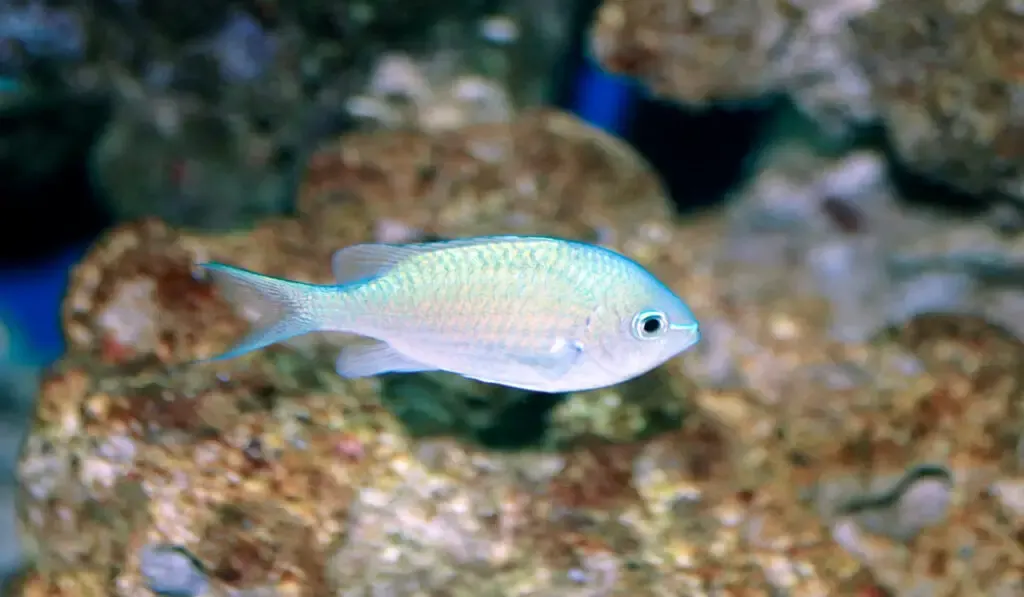
Also known as the Green Chromis or Blue Green Damselfish, these small fish are found inhabiting lagoons and tropical water coral reefs in the Indo-Pacific regions. They swim in large schools that can amount to more than a hundred, usually from 5 to 39 feet (1.5 to 11.8 meters) deep.
Blue-green chromis possess iridescent bluish-green skins, silvery markings under their eyes, and V-shaped tail fins. Male chromis can switch their skin color to yellow, especially during mating seasons.
These compact fish measure 3 inches long. On average, they can live 8 to 12 years.
Unlike other damselfish, blue-green chromis are relatively docile and peaceful. They don’t have any problem being around other fish. Being omnivores, they eat diverse types of marine creatures such as zooplanktons, algae, shrimp larvae, fish eggs, fish larvae, and copepods.
14. Asfur Angelfish (Pomacanthus asfur)
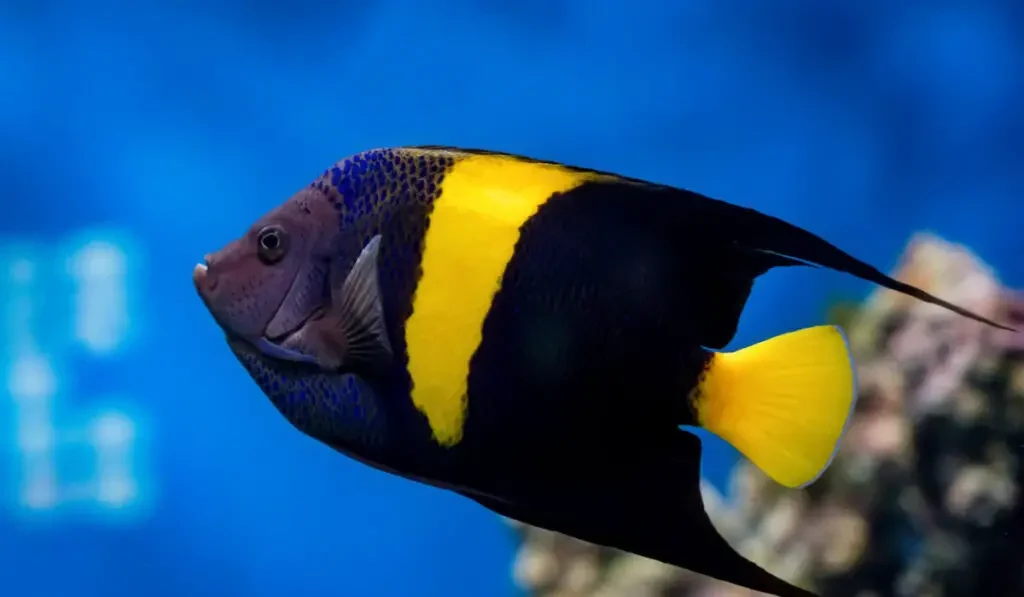
Asfur angelfish are indigenous to the Western Indian Ocean. They are also called crescent angelfish, Arabian angelfish, and half-moon angelfish.
These medium-sized fish usually swim between 10 to 100 feet (3 to 30 meters) underwater and spend most of their time near soft and sheltered inshore reefs.
You can recognize Asfur angelfish by their bright blue bodies covered with large, yellow V-shaped patterns on each side, and bright yellow tail fins. On average, they grow 10 to 16 inches long.
Except for their mating partners, these fish are highly territorial, even toward their own kind.
Asfur angelfish thrive on an omnivorous diet. They eat various marine creatures such as algae, sponges, tunicates, and soft corals. In captivity, these fish live as long as 20 years.
15. Ribbon Eel (Rhinomuraena quaesita)
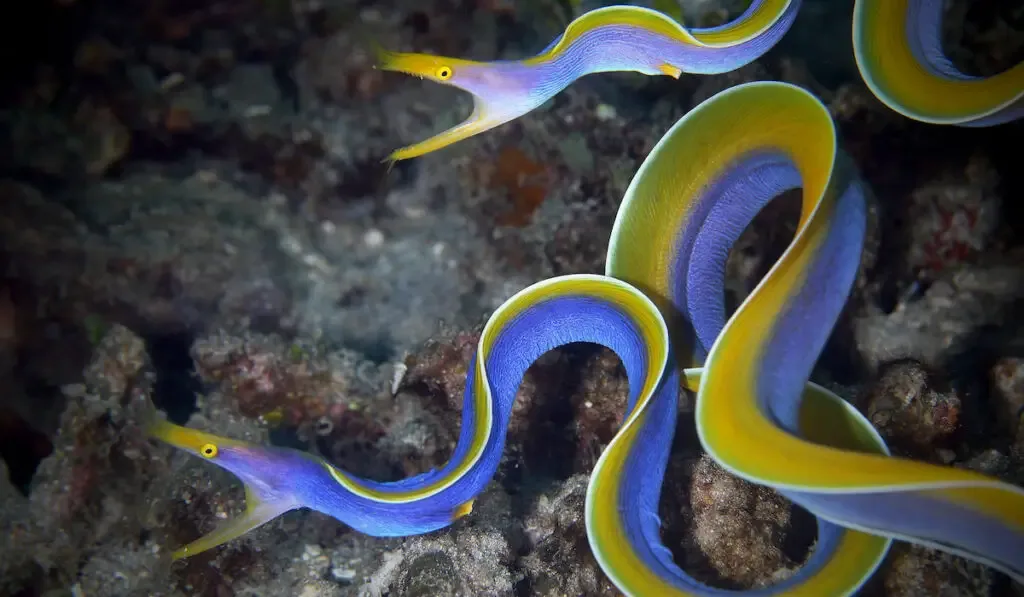
These dragon-like, exotic eels are native to the Indo-Pacific. They are also known as Berni’s eels and leaf-nosed moray eels.
You can spot these eels by their high dorsal fins, long and slender bodies, and whisker-like projections on both the top and lower parts of their mouth.
But what makes ribbon eels truly fascinating is that these creatures undergo three different major changes in their life cycles, including color and gender changes.
During their juvenile stage, these eels have black bodies with long, yellow dorsal fins. As they mature to become males, they turn a bright blue color.
Finally, these male eels will transform into females, completely changing their skin color to bright yellow. At this point, they measure up to 4 feet (1.2 meters) long.
Ribbon eels should be left to live freely in their natural habitats. This is because they don’t survive long in aquariums or constricted spaces. In some cases, they can survive up to 2 years in highly monitored large aquaria or marine parks.
Final Thoughts
All species listed above are just a tiny fraction of saltwater fish that live in the ocean. There are tons of other blue fish species that dwell in the deep oceans and live in freshwater regions.
Most importantly, you should always remember that not all of these fish are created equal. Some are equipped to adapt to life in captivity while others only do well in their own native habitats.
Resources
- http://www.fishingworld.com.au/fish-facts/fish-facts-blue-threadfin-salmon
- https://en.wikipedia.org/wiki/Eleutheronema_tetradactylum
- https://a-z-animals.com/animals/horse-mackerel
- https://www.soleshare.net/horse-mackerel
- https://www.thainationalparks.com/species/blue-ring-angelfish
- https://australian.museum/learn/animals/fishes/blue-ringed-angelfish-pomacanthus-annularis/
- https://en.wikipedia.org/wiki/Atlantic_bluefin_tuna
- https://www.americanoceans.org/species/atlantic-bluefin-tuna/
- https://www.floridamuseum.ufl.edu/discover-fish/species-profiles/thalassoma-bifasciatum/
- https://en.wikipedia.org/wiki/Thalassoma_bifasciatum
- https://www.aquariumofpacific.org/onlinelearningcenter/species/powder_blue_tang
- https://en.wikipedia.org/wiki/Acanthurus_leucosternon
- https://www.biologicaldiversity.org/species/fish/humphead_wrasse/natural_history.html
- https://aqua.org/explore/animals/humphead-wrasse
- https://www.captaintroywetzel.com/fishing-charters/marlin-vs-swordfish
- https://en.wikipedia.org/wiki/Atlantic_blue_marlin
- https://www.fishtrack.com/article/atlantic-blue-marlin
- https://kidadl.com/facts/animals/yellowtail-damselfish-facts
- https://www.saltwateraquariumblog.com/yellowtail-damselfish-care-guide/
- https://animal-world.com/encyclo/marine/damsels/green.php
- https://www.thesprucepets.com/blue-green-chromis-fish-species-profile-4797865
- https://reefapp.net/en/encyclopedia/chrysiptera-cyanea
- https://en.wikipedia.org/wiki/Chrysiptera_cyanea
- https://www.monaconatureencyclopedia.com/chrysiptera-cyanea/?lang=en
- https://animal-world.com/encyclo/marine/angels/cherub.php
- https://en.wikipedia.org/wiki/Cherubfish
- https://www.fishlore.com/profile-pygmy-angelfish.htm
- https://animal-world.com/encyclo/marine/angels/cherub.php
- https://en.wikipedia.org/wiki/Pomacanthus_maculosus
- https://animal-world.com/encyclo/marine/angels/RedSeaAngelfish.php
- https://www.aquaticcommunity.com/Marine-angelfish/Asfur.php
- https://animal-world.com/encyclo/marine/angels/Arabian.php
- https://en.wikipedia.org/wiki/Ribbon_eel
- https://twofishdivers.com/blog/ribbon-eel-facts/
